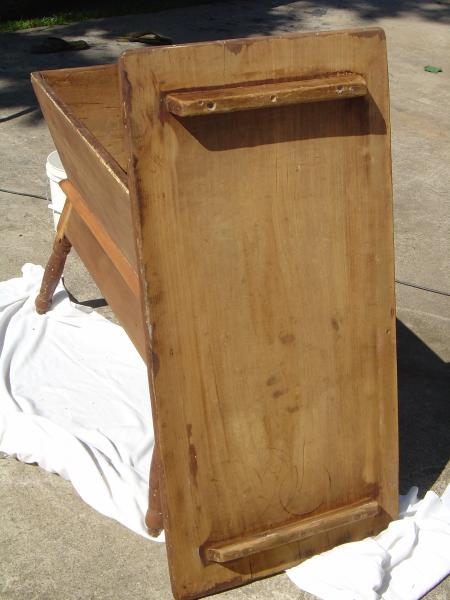Description
I dont know anything about this. I was told it may be an antique dry sink. It has dove-tailed joints and one solid piece of wood for the lid (or top) it has minute piece of cloth around the leg as pictured if you can see. and it is worn but solid. was white at some point, original or not i dont know. looks to have been hand planed.










Re: ????????????????antique dry sink?????????????????????
i guess im not gonna get any help
Re: ????????????????antique dry sink?????????????????????
This is a dough tray(pronounced in PA vernacular dote'ree)...it was used for the raising of dough in making the many loaves of bread needed by the large families of past centuries.
The lid was flipped over and the battens fit into the trough to keep it from slipping around as the dough was kneaded. Then the dough was flopped into the trough and covered by the lid to keep out drafts. Ususlly located near the fireplace, the softwood (pine or poplar) doughtray was the perfect warm place for the yeast to do its work.
The dough was removed from the tray with the aid of a dough scraper, a small, short-handled hoe.
The example you show is particularly nice in that it is dovetailed. Dovetails are darn-near-impossible to cut on the canted sides of doughtrays and cradles. It was a good craftsman madde this.
Re: ????????????????antique dry sink?????????????????????
That's what it is alright, most of these predate the 1840's. They were a really hot item in the 70's and 80's, couldn't keep them in the store. Now they sell at auction in the $200.00- $450.00 range.
Lovejoy
Re: ????????????????antique dry sink?????????????????????
Yes, Lovejoy, THANKS!
(That's not Buffalo Lovejoy, is it?)
This doughtray is nice, too, because it has its original base. I have made many bases over the years. I imagine that the piece of cloth was a clamp to hold the leg together while the glue dried, as it may have beeen broken. This piece is made of poplar, tulip tree wood, from the magnolia family.
Re: ????????????????antique dry sink?????????????????????
And if you look really close...you'll see that it was originally painted red. All softwood furniture....corner cupboards, dry sinks, blanket chests, doughtrays...was painted. (Of course, as soon as you make such a rule, you'll find exceptions....) The people of the early days saw all the wood they cared to see (getting fuel for their fires, building materials for their mid-19th-century housing bubble), and needed color in their lives, so they painted a lot more or their furniture than we think they did. Much of it was also paint-decorated with geometric patterns, flowers, birds, names, dates, horses,
Their eyes were not BOMBARDED with stimuli as ours are. There were no TVs, computers, phones, even books and magazines were quite rare, so little flashes of color....wildflowers, birds, paint, brightly-dyed cloth, were welcomed to their visual fields!
If you ever consider the restoration of a painted piece, you will be most successful if you try to make it appear as if the original paint is all it ever got. In other words, you must study all the wear and damage the piece has accumulated and repaint with the knowledge that the paint could not be present where there is wear or damage. You will end up with a piece about which some will say, wow, that's old...when are you going to "do it over"? Which means refinish it to bring it to a state which we consider acceptable ......."nice".
MUCH value has been lost over the years since 1920, when the collecting of antiques emerged as a popular hobby, by the removal of original surfaces.
I don't know anyone in the field who doesn't kick himself for having ruined a piece or two by such means!
Pain is a good teacher.